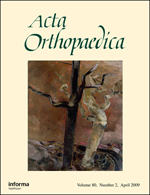
ARTHROPLASTY
Continuous migration of components noted between 12 & 24 months with PSI in total knee arthroplasty
Acta Orthop. 2018 Aug;89(4):418-424. doi: 10.1080/17453674.2018.147086640 patients scheduled for total knee arthroplasty were randomized to surgery completed using either patient specific positioning guides (PSPG) or conventional instrumentation (CONV). Patients were followed for 2 years after surgery for maximum total point motion of the tibial component on radiostereometric analysis. At 2 years, only 20 patients were available for analysis. Results demonstrated, that while the difference between groups in MTPM of the tibial component was not significant, mean MTPM from 1 to 2 years increased in the PSPG group versus no marked increase noted in the CONV group.
Unlock the full ACE Report
You have access to {0} free articles per month.Click below to unlock and view this {1}
Unlock NowCritical appraisals of the latest, high-impact randomized controlled trials and systematic reviews in orthopaedics
Access to OrthoEvidence podcast content, including collaborations with the Journal of Bone and Joint Surgery, interviews with internationally recognized surgeons, and roundtable discussions on orthopaedic news and topics
Subscription to The Pulse, a twice-weekly evidence-based newsletter designed to help you make better clinical decisions
Exclusive access to original content articles, including in-house systematic reviews, and articles on health research methods and hot orthopaedic topics
Or upgrade today and gain access to all OrthoEvidence content for just $1.99 per week.
Already have an account? Log in


Subscribe to "The Pulse"
Evidence-Based Orthopaedics direct to your inbox.
{0} of {1} free articles
Become an OrthoEvidence Premium Member. Expand your perspective with high-quality evidence.
Upgrade Now












































































